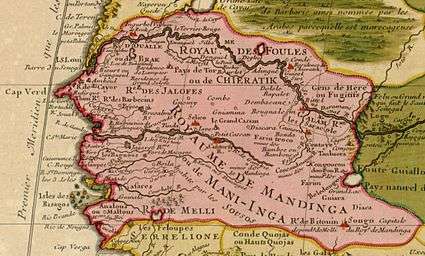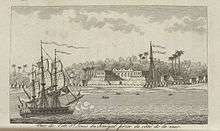Capture of Senegal
| Capture of Senegal | |||||||
|---|---|---|---|---|---|---|---|
| Part of Seven Years' War | |||||||
 A map of Senegal by Guillaume Delisle (1770) | |||||||
| |||||||
| Belligerents | |||||||
|
|
| ||||||
| Commanders and leaders | |||||||
| Henry Marsh | |||||||
| Strength | |||||||
|
200 Light artillery 6 Royal Navy vessels 5 hired armed vessels | |||||||
The Capture of Senegal took place in 1758 during the Seven Years' War with France, as part of a concerted British strategy to weaken the French economy by damaging her international trade. To this end, a succession of small British military expeditions landed in Senegal and captured the French settlements of Saint-Louis and Gorée, seizing French vessels and supplies. By late 1758 the Senegalese coast was entirely in British hands with local administration controlled by the first British Governor of Senegal, Lieutenant Colonel Richard Worge.
Background
The plan was devised by an American merchant Thomas Cumming who had previously visited West Africa, and extensively considered the possibilities for a British attack.[1] The plan was built around Britain's growing dominance on the Oceans which had dramatically reduced French sea power. A British naval force under Captain Henry Marsh would sail from England and head for the coast of West Africa, where it would land an amphibious force at the Senegal River. They would then capture the French fort at Saint-Louis. Cumming planned to raise support from local African forces, who would rendezvous with the British and attack the French.[2]
The French settlements in Senegal had little strategic value,[3] but they were important to France's global trade in slaves. They were also home to a substantial industry in natural gums. The principal object of the expedition was therefore to damage the French economy by cutting access to these industries. Such expeditions were part of Southern Secretary William Pitt's strategy of destroying France's capacity to continue the war by draining her of funds.[3]
Expedition

Two hundred troops and two warships were to take part in the expedition. The forces departed from Plymouth in early 1758, and after a brief stop for supplies at Tenerife they reached the coast of West Africa in April. Cumming had gone ashore to secure support amongst locals, and they launched a landward blockade of the fort.
Marsh then put his troops ashore. The sudden arrival of British troops took the garrison completely by surprise. On 1 May they surrendered the fort, and the resident traders swore allegiance to the British.[4] Not a single Briton had been killed in the taking of the settlement.[5]
Cumming's ships returned home crammed with captured goods valued at hundreds of thousands of pounds. Pitt was extremely pleased at the ease with which the British forces had taken Saint-Louis. He was also impressed by the large quantities of gum arabic which were brought back to Britain, opening up a much cheaper source of the good for silk-weavers.[6]
In the wake of the missions' success, two further expeditions were sent out that year, which captured the Island of Gorée and the French trading station on the Gambia.[7] Pitt would have liked to have launched further expeditions but could not in the face of opposition from the Duke of Newcastle who feared that stripping the British Isles of troops would leave them vulnerable to invasion.
Aftermath
Along with attacks against Canada, the West Indies and Philippines, the capture of Senegal demonstrated the new global reach of the Royal Navy and the increasingly global nature of conflicts between the competing European powers who were battling for dominance and control of resources on several continents – as a consequence historians have labeled it the first 'world war'.
Ownership of the West African settlements became a major source of contention between Britain and France during the peace talks that led to the 1763 Treaty of Paris. The negotiations centred on a potential return of some of the captured outposts. Britain was keen to keep hold of the Senegalese mainland, but willing to return the island of Gorée. Ultimately Britain kept Saint-Louis and the Senegal mainland.
The British were keen to build up their presence in West Africa, and intended to use Senegal as a starting point for this. They raised the Africa Corps, a special unit of troops under the command of Charles O'Hara, to protect the new possession.
The French were unhappy about the loss of this valuable colony, and planned to regain them in any future conflict with Britain. In 1764, the French launched incursions against the coast of Senegal from Gorée angering the British cabinet.[8] In 1779 during the American War of Independence a French force landed and seized Saint-Louis, and Senegal was ceded to them by Britain as part of the Treaty of Paris that ended the war in 1783. However French control remained sporadic until the mid-nineteenth century.
See also
References
Bibliography
- Anderson, Fred. Crucible of War: The Seven Years' War and the fate of Empire in British North America, 1754–1766. Faber and Faber, 2000.
- Brown, Peter Douglas. William Pitt, Earl of Chatham: The Great Commoner. George Allen & Unwin, 1978.
- Dull, Jonathan R. The French Navy and the Seven Years' War. University of Nebraska, 2005.
- McLynn, Frank. 1759: The Year Britain Became Master of the World. Pimlico, 2005.
- Simms, Brendan. Three Victories and a Defeat: The Rise and Fall of the First British Empire. Penguin Books (2008)
Coordinates: 16°02′00″N 16°30′00″W / 16.0333°N 16.5000°W